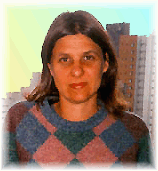Brazil's Museum of the PersonBy Thom Gillespie |
|
"I believe that new technologies should not be used merely because they are 'new technologies,' that is, merely as a way of trying to follow the pace of social evolution. But, when they offer a whole range of new possibilities, opening up a new world for the development and publishing of knowledge, then they become fascinating and unpredictable adventures. They become paths of which we are unable to know the end, but which we certainly cannot neglect to walk on." |

|
|
Last March I offered a workshop called "Immersive Histories" at the Museums and the Web Conference in New Orleans. Ninety minutes into the workshop we took a short break, at which time three new folks appeared at the door. They introduced themselves as Karen Worcman, Jose Santos Matos, and Rosali Nunes Henriques from the Museum of the Person in Brazil. They said they had wanted to take my workshop but by the time they had arrived at the conference, it was filled. Over lunch, they explained the Museum of the Person. It was immediately obvious to me that they are combining art, community, education, and technology in interesting ways. A VIRTUAL MUSEUMThe Museum of the Person, Museu da Pessoa in Portugese, has been a company since 1992 whose aim is to collect, organize, preserve, and publish the life stories of ordinary people. Ms. Worcman explains it: "Philosophically, the purpose we had in mind was to create the possibility of preserving, and turning it into an information source, the life history of each and every person. Our concept of work and method were inspired by the oral history movement led by Paul Thompson (1978), which considers oral history an instrument allowing anonymous people to become part of history." Originally, the Museum worked in text, video, and CD-ROM. In 1997, the Museum created a Web site to allow anyone to add his or her biography together with associated multimedia, to have their life stories preserved on the Web. "The idea of establishing a 'museum' that preserves 'people's life stories' forced us to reconsider our standard idea of 'place,'" Worcman says. "There are many people, and their voices are non-material. Therefore, the 'place' to gather their stories had to be a 'virtual' place."Currently, the Museum has received more than 150 histories with images, and it is receiving 15 new histories a week containing testimonies from the elderly, young adults, and children. The only control the Museum exercises is an email confirmation and a copyright signature, and they do filter submissions for advertising and offensive materials having nothing to do with personal histories. Nearly 500 people visit the Museum daily. I conducted an email interview with the folks at the Museum last spring and obtained a little more information about their project (see "The Interview," next page). We discussed the origins and development of the Museum, its funding, and the subjects featured in it. For instance, I found out that the Museum of the Person was founded by five talented people: Jose Santos Matos, a journalist, poet, and videographer; Karen Worcman, a historian with a master's degree in linguistics; Mauro Malin, a historian and journalist; Marcia Ruiz, also a historian but with a marketing background; Claudia Leonor Guedes de Oliveira, a student of history; and Mauro Rech, a multimedia programmer who developed the first museum prototype. And that it began as a company in 1992, but that the first actual histories of people were collected in 1991 at the Museum of the Image and Sound in São Paulo. The Museum did not have initial funding; each of the founders put in some money to get started. Their first project was a multimedia museum for the São Paulo football club, which devleoped from the concept of a room with trophies in it to a multimedia kiosk, to a complete museum. They continued selling projects, and with the money from those, they were able to start doing interviews, buy equipment, and so on. Presently, the staff of the Museum of the Person includes Worcman, Matos, and Henriques, who are partners; a secretary; some student trainees; 20 or so researchers; specially skilled partners who help sell the projects and maintain customer databases; and counselors/consultants who help develop ideas. Most of the people working there are journalists, historians, museologists, marketers, and a Web designer. They occupy a 75-meter square office building with no walls or private tables, though there are tables where people meet and a computer work station. Notable is the large picture window featuring a view of São Paulo and the sky. Worcman explains their working philosophy: " ... that each person has to have independence and take responsibility for his or her work. No one checks up on others. We make a plan and do it till it is done. No one becomes a functionary." They discover people with stories to tell by first determining the theme they want to feature and then going to the associations, to the streets, and phoning people. "We never select a story because everybody has a story," Worcman points out. "It depends more on who wants to tell a story. This is how it happens on the Net, for example."  The Museum of the Person |
|